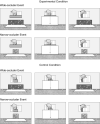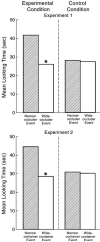Young infants' reasoning about hidden objects: evidence from violation-of-expectation tasks with test trials only
- PMID: 15178376
- PMCID: PMC4215956
- DOI: 10.1016/j.cognition.2003.09.012
Young infants' reasoning about hidden objects: evidence from violation-of-expectation tasks with test trials only
Abstract
The present research examined alternative accounts of prior violation-of-expectation (VOE) reports that young infants can represent and reason about hidden objects. According to these accounts, young infants' apparent success in these VOE tasks reflects only novelty and familiarity preferences induced by the habituation or familiarization trials in the tasks. In two experiments, 4-month-old infants were tested in VOE tasks with test trials only. The infants still gave evidence that they could represent and reason about hidden objects: they were surprised, as indicated by greater attention, when a wide object became fully hidden behind a narrow occluder (Experiment 1) or inside a narrow container (Experiment 2). These and control results demonstrate that young infants can succeed at VOE tasks involving hidden objects even when given no habituation or familiarization trials. The present research thus provides additional support for the conclusion that young infants possess expectations about hidden objects. Methodological issues concerning the use of habituation or familiarization trials in VOE tasks are also discussed.
Figures



Similar articles
-
Reasoning about a hidden object after a delay: evidence for robust representations in 5-month-old infants.Cognition. 2003 Jul;88(3):B23-32. doi: 10.1016/s0010-0277(03)00045-3. Cognition. 2003. PMID: 12804819 Free PMC article.
-
Detecting continuity violations in infancy: a new account and new evidence from covering and tube events.Cognition. 2005 Mar;95(2):129-73. doi: 10.1016/j.cognition.2002.11.001. Cognition. 2005. PMID: 15694644 Free PMC article.
-
Décalage in infants' knowledge about occlusion and containment events: converging evidence from action tasks.Cognition. 2006 Mar;99(2):B31-41. doi: 10.1016/j.cognition.2005.01.010. Epub 2005 Jun 6. Cognition. 2006. PMID: 15939414 Free PMC article.
-
Infants' reasoning about hidden objects: evidence for event-general and event-specific expectations.Dev Sci. 2004 Sep;7(4):391-414. doi: 10.1111/j.1467-7687.2004.00357.x. Dev Sci. 2004. PMID: 15484586 Free PMC article. Review.
-
The developmental origins of naïve psychology in infancy.Adv Child Dev Behav. 2009;37:55-104. doi: 10.1016/s0065-2407(09)03702-1. Adv Child Dev Behav. 2009. PMID: 19673160 Review.
Cited by
-
Rooks perceive support relations similar to six-month-old babies.Proc Biol Sci. 2010 Jan 7;277(1678):147-51. doi: 10.1098/rspb.2009.1456. Epub 2009 Oct 7. Proc Biol Sci. 2010. PMID: 19812083 Free PMC article.
-
Making Sense of Infants' Differential Responses to Incongruity.Hum Dev. 2020 Oct;64(2):55-63. doi: 10.1159/000509980. Epub 2020 Sep 17. Hum Dev. 2020. PMID: 34294946 Free PMC article.
-
Four-day-old human neonates look longer at non-biological motions of a single point-of-light.PLoS One. 2007 Jan 31;2(1):e186. doi: 10.1371/journal.pone.0000186. PLoS One. 2007. PMID: 17264887 Free PMC article.
-
Babies and brains: habituation in infant cognition and functional neuroimaging.Front Hum Neurosci. 2008 Dec 2;2:16. doi: 10.3389/neuro.09.016.2008. eCollection 2008. Front Hum Neurosci. 2008. PMID: 19104669 Free PMC article.
-
Youngsters do not pay attention to conversational rules: is this so for nonhuman primates?Sci Rep. 2011;1:22. doi: 10.1038/srep00022. Epub 2011 Jun 23. Sci Rep. 2011. PMID: 22355541 Free PMC article.
References
-
- Aguiar A, Baillargeon R. Eight-and-a-half-month-old infants’ reasoning about containment events. Child Development. 1998;69:636–653. - PubMed
-
- Aguiar A, Baillargeon R. 2.5-month-old infants’ reasoning about when objects should and should not be occluded. Cognitive Psychology. 1999;39:116–157. - PubMed
-
- Aslin RN. Why take the cog out of infant cognition? Infancy. 2000;1:463–470. - PubMed
Publication types
MeSH terms
Grants and funding
LinkOut - more resources
Full Text Sources

